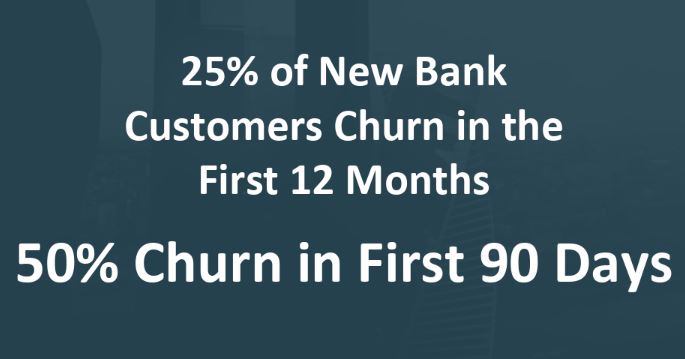You may be no stranger to challenges in the retail banking industry. Here’s an alarming fact that you may have come across if you’re from this sector:

This poses a huge challenge for sales & marketing professionals. Luckily, data and analytics can be their allies. With the right insights, it’s possible to solve this and more challenges that plague the sector.
Let’s take a look at the top 5 challenges in the retail banking industry. Furthermore, let’s understand how data can help you solve each one.
Challenges in the Retail Banking Industry
We will analyze each challenge, describe how it affects your strategy, and propose data-driven solutions to help you navigate these hurdles with ease.
Challenge 1: Increasing Competition
The banking industry has seen increasing competition, especially from the FinTech sector. The user-friendly and digital nature of FinTech companies offers customers the flexibility they need and the freedom to choose between different providers.
How This Affects You: Customer Retention
Retail banking customers find it easy to switch between providers. This is now possible as it is less of a hassle to open or close accounts. This means that it has become harder to keep customers. Sales & Marketing professionals thus spend more on retaining and re-acquiring customers.
[custom-cta]
How Data Can Help: Retail Banking Customer Segmentation
Retail banking customer segmentation is key to retaining customers. Similarly, it can help drive up their lifetime value (LTV). Lifecycle marketing can help you create engaging conversations in every stage of their journey. By segmenting customers this way, you can apply a marketing strategy that communicates the right message at the right time.
For instance, running a data model can help you predict which customers are most likely to churn. This way, you can reach out to them to understand their needs and provide an offering that suits their needs. By reaching out to them in a timely manner, you reduce the risk of churn.
Challenge 2: Operational Silos
You may find that different departments in your institution collect different data-points on your customers. Overall, it is possible to develop a rich picture of who your customer is. However, the challenge is that information rests in silos. As a retail banker, you may have access to transactional data. Wealth managers in your institution may have access to the estimated net worth, home loans may have information on property value, etc.
How This Affects You: Missing an Integrated View of the Customer
Since information rests in silos, it becomes difficult to see a 360-degree view of the customer. This further restricts you from being able to anticipate their needs or upsell products.
How Data Can Help: Omnichannel Marketing
When you store data in an integrated manner, you allow every relevant team member to understand the big picture. Doing this allows your institution to have better insights into your customers. When you combine your own data with third-party information, you can have a richer view of your customers. For instance, wealth screening can add a variety of insights on demographics, lifestyle, interests, and affinities.
With richer insights, you can have an omnichannel approach in your outreach. You will be able to provide consistent, personalized service. Furthermore, this can be done no matter which touch-point a customer interacts with you on. For instance, a customer may look up use your mobile banking app to information on opening another savings account. When they next come into a branch, a representative can ask them if they still have questions about this or need assistance in setting up an account.
Challenge 3: Increasing Costs
Another challenge in the retail banking industry is the ever-increasing costs. Costs are going up in every sphere ranging from marketing to compliance. Increasing competition and pressure on customer retention, when combined with increasing costs, presents a major challenge to retail banks.
How This Affects You: Reduced ROI
Greater costs result in reduced ROI. When you spend more on acquiring and retaining customers, your team will have more pressure to drive up the ROI on each account.
How Data Can Help: Predictive Prospecting
Taking retail banking customer segmentation a step further, you can focus on highly targeted prospecting when it comes to customer acquisition. In fact, your top customers today can help you find your next best prospects. You can achieve this by using a look-alike model.
A model like this can recognize patterns of traits among your top customers. These traits can then be used as filters when prospecting for new customers. Thus, by finding new prospects who match your existing customers, you are ensuring that your approach is much more targeted. This further enables you to predict customer behavior.
Challenge 4: Pressure to Improve Customer Experience
Since the retail banking industry is challenged by increased competition, institutions have greater pressure to improve the customer experience. The experience you offer should be able to set you apart from competitors. Thus, it should allow you the advantage of nurturing long-term relationships with your customers. Doing this needs an in-depth understanding of customer needs.
How This Affects You: Requires Broad Systemic Changes
Offering your customers a better experience may need sweeping, systemic changes. For instance, your brand may have to become more relatable. Your employees have to learn how to make customers feel appreciated with every interaction.
How Data Can Help: Identifying Money in Motion
One of the ways to offer the best customer experience is by offering customers exactly what they are looking for when they need it the most. Again, this goes beyond the level of retail banking customer segmentation. Data can help you identify money-in-motion. This means you can trace your customer’s life stage and offer products and services that are relevant and timely.
When customers know you are looking out for them, they enjoy a better experience with your brand. Furthermore, you increase retention with every additional product or service that you offer them.
Challenge 5: Employee Retention & Engagement
Customer retention is important, of course. But for your institution to have a good culture, it is necessary to think about employee retention as well. When you experience high employee turnover, it becomes harder to build a sense of company culture.
How This Affects You: Loss of Company Culture
For you losing employees means an erosion of company values. Additionally, this also results in gaps in knowledge transfer. These gaps, especially when they pertain to your customers can create holes in customer experience.
For instance, let’s say a senior citizen is used to coming and in and interacting with the same teller at one of your branches. This teller will know them well enough to serve them quickly or offer them solutions based on their needs. If this customer comes in and sees a new face within short intervals, it becomes harder for them to build long-term trust in your institution.
How Data Can Help: Every Employee Becomes a Marketer
When you create an integrated system of data and provide actionable insights to every relevant employee, you create a culture of ownership. Every employee feels accountable for customer satisfaction. With this becoming an organization-wide outlook, your customers will surely feel the difference in the personalized service that they receive. This can also help you address other challenges in retail banking such as low retention, high costs, and increasing competition.
Mitigating Challenges to Thrive in the Retail Banking Industry
Thus, data and analytics can help set you apart in a crowded marketplace. Remember that innovation can come not only from you but also your clients. Learn how to how US Bank achieved success by elevating client-led innovation.
